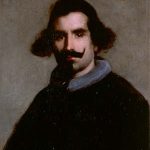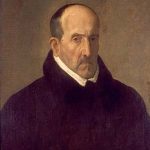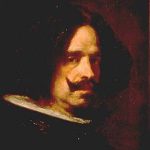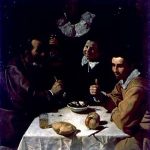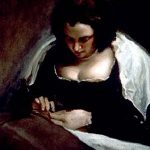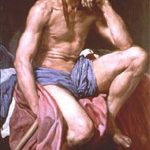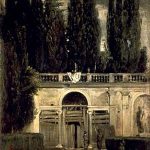Velázquez_His third journey to Italy
March 30 2001 / July 01 2001
Roma – Palazzo Ruspoli (134.331 visitors)
Catalogue – Electa
- Attribuito a Diego Rodriguez Velázquez Autoritratto
- Attribuito a Diego Rodriguez Velázquez Ritratto del Cardinale Gaspare Borgia(1643 circa)
- Copia o bottega di Velázquez Ritratto di Luis de Gòngora (1623 circa)
- Diego Rodriguez Velázquez Autoritratto (1650 circa)
- Diego Rodriguez Velázquez Cavallo bianco (1634-1638)
- Diego Rodriguez Velázquez Il buffone Calabacillas (1628-1632 circa)
- Diego Rodriguez Velázquez Il pranzo (1616-1618)
- Diego Rodriguez Velázquez Juan Mateos (1632 circa)
- Diego Rodriguez Velázquez L’apostolo San Paolo (1620 circa)
- Diego Rodriguez Velázquez La cucitrice (1638-1650 circa)
- Diego Rodriguez Velázquez La tentazione di San Tommaso d’Aquino (1632-1633)
- Diego Rodriguez Velázquez Le lacrime di San Pietro
- Diego Rodriguez Velázquez Marte (1642)
- Diego Rodriguez Velázquez Ritratto del cavaliere di San Giacomo (1652)
- Diego Rodriguez Velázquez Ritratto dell’Infanta Margherita
- Diego Rodriguez Velázquez Ritratto della regina Marianna d’Austria (1652 circa)
- Diego Rodriguez Velázquez Santa Rufina (1628-1632 circa)
- Diego Rodriguez Velázquez Testa di Apostolo (1619-1620 circa)
- Diego Rodriguez Velázquez Villa Medici a Roma (circa 1630)
The exhibition “Velázquez, His third journey to Italy” was organized as part of the increasingly fruitful cultural exchanges between Spain and Italy, which have already given rise to major exhibitions on El Greco at Palazzo delle Esposizioni and on Goya at Palazzo Barberini.
Never has an exhibition had a more illustrious beginning: on September 29, 1998, during his official visit to Italy, H.R.H. Juan Carlos I, King of Spain, expressed his desire, in a speech to the Chamber of Deputies, to see an exhibition on the works of Velázquez realized in Rome as part of the agreements being drafted between Italy and Spain. The “royal desire” received an immediate response from the Foreign Ministers and Ministers of Cultural Heritage of both countries, as well as from Fondazione Memmo, which organized the exhibition in the prestigious halls of the Roman Palazzo Ruspoli.
Rome was the third most important city in Velázquez’s life, after Seville and Madrid. He lived there twice, loved it deeply, and left with great regret each time. In Rome, he was influenced by the great Italian art, which profoundly changed his way of painting. The free Roman life, rich in inspiration and artistic and human encounters, transformed him as a man and as an artist. He left the most Roman part of his blood in Rome: his only son, Antonio Rodríguez de Silva.
During his lifetime, the painter from Seville made two trips to Italy. The first, between 1629 and 1631, was one of those study trips considered essential for the formation of a young artist. It took him from Genoa to Venice, where he studied the works of Titian and Tintoretto, and from there to Florence and Rome. In the Eternal City, he stayed for almost a year, contemplating the masterpieces of Michelangelo and Raphael in the Vatican, immersing himself in the Roman artistic environment, and associating with leading figures such as Pietro da Cortona and Andrea Sacchi.
Twenty years later, the second trip to the Italian peninsula had a different purpose. Velázquez, by then an established court painter, Superintendent of the Works of the Alcazar, and Chamber Assistant to Philip IV, was sent by the sovereign to Italy to select works of art for the decoration of the royal palace in Madrid. His fame preceded him this time, and, in addition to visiting the great Roman collections, he was highly sought after by the nobility and the papal court. During this trip, he produced some of his greatest masterpieces.
Some scholars have suggested that the painter visited Italy a third time, but this hypothesis has never been validated. The upcoming spring exhibition of Velázquez’s works in Rome will be a true “Third Journey to Italy.”
The project for the exhibition at Fondazione Memmo is ambitious. It aims to provide a comprehensive image of the artist, following him throughout his life and allowing visitors to appreciate the evolution of Velázquez’s painting style and changes in technique and style. This ambitious project is challenging because Velázquez was not a particularly prolific painter, and over 70% of his paintings are preserved in the Prado Museum, forming a fundamental and, in many ways, “inmovable” part of its heritage. Moreover, works by the “painter of painters” present in many of the world’s great museums and international collections are rarely moved from their locations, where they attract scholars and serve as a reference point for all visitors.
Therefore, the only chance to assemble a significant collection of paintings both in quantity and quality, as is now offered to visitors at Palazzo Ruspoli, was to develop and organize a scientific project of breadth and coherence capable of persuading owners, both public and private, to overcome any legitimate doubts regarding the appropriateness of depriving themselves and their audiences of works of such great importance.
For the first time, absolute masterpieces, such as “Mars” and “Villa Medici” from the Prado, the “Self-Portrait” from Valencia, and “The Seamstress” from Washington, have left their locations in the world’s great museums and in the most important private collections. Velázquez’s works left Rome on the exact same day, 350 years apart, on which the Spanish master left the city he had loved so much and that had immediately recognized his genius.

